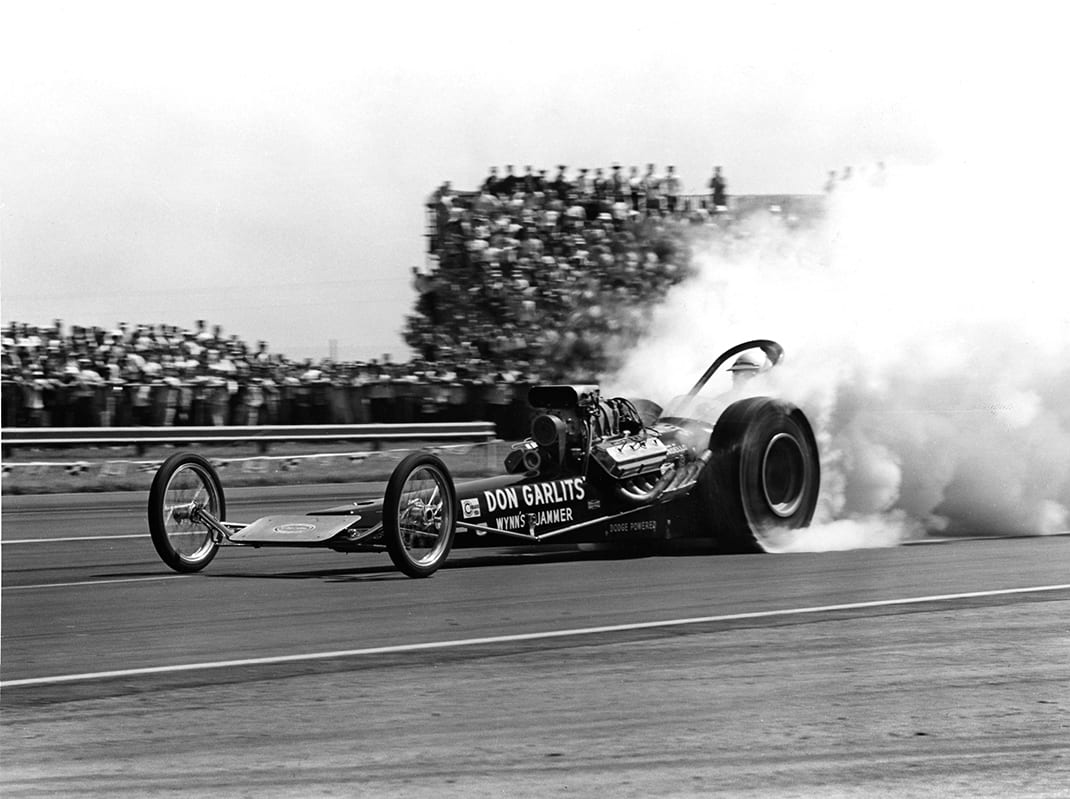He returned to action in 1991, but detached retinas from the negative G-forces that slow a dragster after the run sidelined him again. He reappeared and retired quickly in 1998 and 2003. His last competitive Top Fuel race was at Atlanta Dragway, at age 71.
“Retirement’s easy. I’ve done it dozens of times,” he joked in 2008. But he was back at the 2009 U.S. Nationals, competing in a specially built Dodge Challenger Drag Pak, the first one off Mopar’s assembly line.
“I like my Dodge Challenger Drag Pak much better than a (modern) dragster,” Garlits said at the time. “It takes 25 people to get a dragster to the line these days. All I have to do with the Dodge Challenger is turn the key and take it there. When the light turns green, I have a 10-second ride, which is almost three times what I used to get. And I even have time to look at the tach and shift gears.”
His focus today is blazing quieter trails with electric-vehicle technology.
This past July 19, on the 50th anniversary of America’s moon landing, Garlits clocked a 189.04 mph speed on the Palm Beach Int’l Raceway quarter-mile in 7.235 seconds. That fell short of his 200 mph target. But if Garlits has a goal, rest assured he will keep pursuing it. All anyone would have to do is tell him he can’t and he’ll accomplish what he sets out to do.
He learned that lesson from his father, Edward Elmer Garlits — and a pile of bricks.
When Garlits was two months old, his home burned to the ground. His father rescued him from the inferno. His dad decided to rebuild the home two years later and bought a truckload of bricks, to start with the fireplace. But the delivery driver didn’t want to pull up to the home site, so he dumped the giant pile of bricks on the ground a fair distance away.
Garlits’ father was a Westinghouse engineer who, according to his son, was on the team that produced the modern electric iron and electric fan. And he calculated that his little 2-year-old Donnie could use his little red wagon to haul the bricks, four at a time, from sunup until sundown, to help move them to the building site in about a week.
But his mother had a fit, protesting to his father that “the baby” was not capable of doing a man’s work. She thought he might hurt himself and argued that the bricks were too heavy and that the process would take far too long. As a 76-year-old man, Garlits recalled thinking, “Who’s a baby?! I’m not a baby!” and said he wanted to move those bricks simply because his mother said he couldn’t.
“My dad told me when I was little that I could do anything I put my mind to,” Garlits said. “I thank him every day. He was a hard-working, tough son of a gun. I inherited those genes, no doubt about it.”
Through the years, Don Garlits has made technical strides for the sport that allowed him to be the first to cover the quarter-mile at 170, 180, 190, 200, 240, 250, 260 and 270 mph. And he has ridden the evolutionary waves that management changes, corporate America’s impact, rising costs and the phenomenon of technology outpacing the tracks have generated.
“I just loved it” is Garlits’ explanation of why he devoted his life to the sport. “I liked the idea of two cars lined up side by side, not bumping into one another. It was one person against one person, one machine against one machine. There was a winner and a loser. It was real simple.”
However, as he rose to the top, he discovered nothing in drag racing was simple.
The Top Fuel legend who grew up on the wrong side of the drag-racing tracks in Tampa and roughly rocked the cradle of the Southern California-born sport often found himself on the wrong side of public opinion and of NHRA founder Wally Parks.
“I didn’t like Wally Parks. I respected him. That’s about it,” Garlits said. “He did a great job of forming the NHRA, to get the guys off the street. But he was a tough guy to deal with. He was very stubborn and it was his way or the highway. We rubbed each other raw in that way. There are always things I wanted to improve the sport and he didn’t think they would improve it. I wanted the purses to be higher because he was asking us to go to a lot of races and we weren’t making any money doing it.
“Finally, in 1972, I had a meeting with him,” Garlits continued. “I said, ‘Wally, that U.S. Nationals needs to pay $25,000.’ He said, ‘It’ll be light years before it pays $25,000.’ The racers and I got together and formed an association, and we had our own race at Tulsa on Labor Day — and we did pay $25,000, Funny Car, Pro Stock and Top Fuel,” Garlits said. “And it changed the whole sport. Purses went up after that.”
Click below to keep reading.
